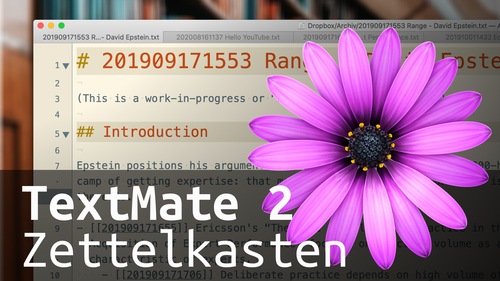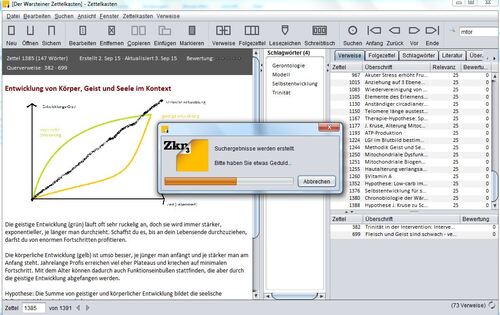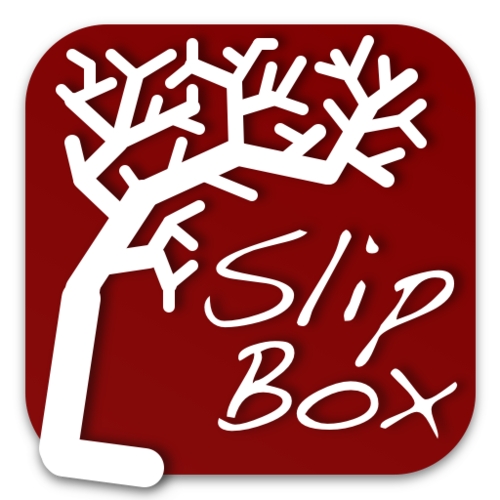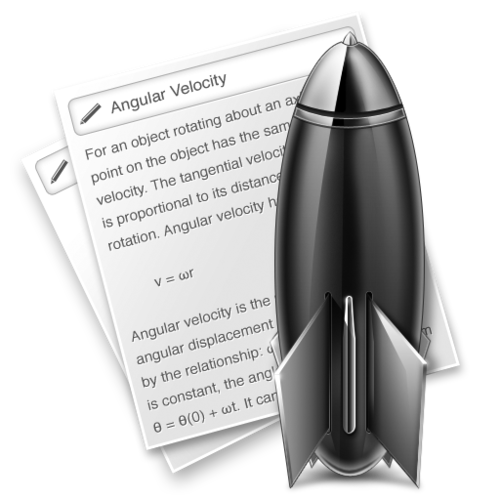Posts tagged “mac”
Video Demo: TextMate as a Zettelkasten App

TextMate is a free, open-source macOS text editor that we mention on this site since forever. It is also damn good at navigating files in a big folder. So it’s a good alternative to dedicated Zettelkasten software. In this video, I demonstrate the basic interaction patterns for TextMate to get a plain text Zettelkasten working: how to navigate around, make use of the folder-relative “Open Quickly” command, and create new notes. You know, everything you really need to be productive.
iA Writer as a Zettelkasten Note Archive
Lorenzo wrote an article about how to use iA Writer for macOS as your Zettelkasten note archive. Apparently, iA Writer has a sufficiently quick search for large archives (10,000 notes big, in fact), which surprises me.
As a native macOS app, you can use iA Writer to sync with Dropbox, iCloud, and other folder-based sync services and either use their mobile or Windows counterparts, or whatever else you like. No boxing-in.
Have a look at Lorenzo’s review for all the juicy details. Great work!
Is Bear for macOS a Zettelkasten Archive Fit?
I spent a few minutes importing a copy of my archive into Bear, a note-taking app for macOS. Bear seems to be popular at least because of its clean look. This is by no means a review, just a first glance at the app. Importing 3941 files took 37:50 seconds and produced 2448 notes (I have no clue why 1500 files went missing or which ones that were). Search is pretty fast afterwards. So the speed of finding and entering notes is not a show-stopper, quite the contrary.
Minimal Writing on the Mac ebook
After Sascha’s great release of the Zettelkasten book, here’s a short e-book from yours truly. It’s a pragmatic guide to get to know the really essential tools for any writer. It’s called Minimal Writing on the Mac.
You can buy the book on various locations:
- iBooks Store
- Kindle Store
- PDF, ePub, and kindle files directly from me
Also take a look at the Productive Writer’s Bundle where I participate with the Word Counter for Mac this November.
Since I’m trying to make a living of my work, it’d be awesome if you shared this with friends and on social media to support me and my writing.
Switching from Zkn³ to a Plain Text Approach

Erik Pfeiffer joins us today to write about his experience with the well-known Zettelkasten application by Daniel Lüdecke. Read the full article to get to know the good and the bad from Erik's point of view and why he switched to a plain text approach later.
DEVONthink as a Zettelkasten Note Archive

Today we host our good friend Marko as he tells us of the basic note-taking capabilities of DEVONthink and its appliance to the Zettelkasten method. The Zettelkasten method propagates heavy use of the note archive, stuffed with your own interpretations of things you have learned. The user we have in mind usually is a student of humanities, reading a lot and writing a lot. DEVONthink is capable of doing far more than managing notes, though. It can also in part replace a reference manager. Or you may benefit from its ability to deal with large amounts of files when it comes to seeking similarities in original sources. This can become really interesting for historians, for example.
Zettel Note Header Automation in nvALT

An essential principle of a Zettelkasten is its flexibility. From there you can derive maxims like “you should avoid proprietary software”, and “you should use plain text notes to ensure longevity”. That’s why I don’t use a fancy application with lots of spectacular features but the simple nvALT instead. Here’s how I automate note creation to speed up my workflow.
SlipBox (Mac) Note Archive Review

Here used to be a review about the macOS app “SlipBox”. Sascha and Christian don’t evaluate apps that compete with The Archive anymore for obvious reasons, so this review had to go the way of the dodo. See our review policy for details.
Using nvALT as a Zettel Note Archive

I want to start this series of reviews with a software I’m fairly familiar with. While most things apply to the Notational Velocity base application, I will talk about nvALT exclusively in this review. nvALT is a fork by Brett Terpstra and David Halter of the original Notational Velocity, which was created by Zachary Schneirov, and a few modifications by yours truly. It’s Open Source, free, and very popular.